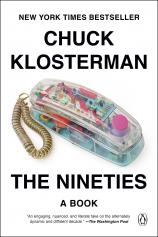The Nineties: A Book
Review
The Nineties: A Book
The 1990s are having a moment. Last year, FX revisited the Bill Clinton-Monica Lewinsky saga in “Impeachment: American Crime Story,” and HBO got the “Friends” cast together for a splashy reunion. So far in 2022, Hulu has launched a TV series about Pamela Anderson and Tommy Lee’s infamous sex tape, and Dr. Dre and Snoop Dogg headlined the Super Bowl halftime show. Meanwhile, Pitchfork has announced that CDs are, bafflingly, making a comeback.
Cultural critic Chuck Klosterman’s latest effort, THE NINETIES: A Book, seems to have arrived at exactly the right moment. Twenty-plus years on, people are ready to revisit --- and reassess --- the decade that brought us grunge, presidential sex scandals and the birth of the internet.
"Klosterman has a distinct affection for the ’90s that comes through in his writing. But he is still a disaffected Gen Xer, and he’s able to view the decade with a mix of detachment and skepticism that keeps him from slipping into empty nostalgia."
Klosterman moves through the decade in roughly chronological order. He argues that the ’90s really began in September 1991 with the release of Nirvana’s Nevermind, when the decade “became a recognizable time period with immutable values.” It lasted through the attacks of September 11, 2001. But this isn’t a strict history, as the subtitle indicates. It’s an examination of a grab bag of quintessentially ’90s moments and phenomena (Zima and Crystal Pepsi, Ross Perot, Dolly the Sheep, Michael Jordan’s baseball career). And it’s an attempt to unpack how the last decade before ubiquitous digital connectivity shaped us, particularly those who experienced it as young adults.
Klosterman is, as he readily admits, a “white heterosexual cis male” whose “experience across the nineties was comically in line with the media caricature of Generation X.” That perspective shapes this work, for better or for worse. An early chapter offers a nuanced take on Nirvana, whose “paradoxical aesthetic” --- marked by Cobain’s ambivalence about his rock star status --- “ended the dominance of rock as an ideology.” It’s followed by a short essay on the late rapper Tupac Shakur, whose cultural legacy is equal to, if not greater than, Cobain’s. Unfortunately, that chapter ends almost as soon as it begins, though Klosterman does acknowledge the disparity in a self-critical footnote.
THE NINETIES is full of moments like this that will leave readers asking, “But what about…?” Fashion (beyond a few token mentions of flannel) is basically ignored. Beanie Babies, “Sex and the City,” Harry Potter and the death of Princess Diana merit nary a mention. AIDS is addressed glancingly. Readers will find nothing on Clinton’s controversial “don’t ask, don’t tell” policy, NAFTA or welfare reform. These aren’t necessarily criticisms. A book with this broad of a scope inevitably leaves certain things out. And generally, Klosterman has chosen interesting, if occasionally quixotic, subjects to explore, often finding surprising connections between seemingly unrelated events and trends.
Economic wonk Alan Greenspan, at the height of his influence in the ’90s, is placed in opposition to touchy-feely talk show host Oprah Winfrey, setting up an “undeclared war between feeling and unfeeling.” A discussion of comedian Pauly Shore, the star of several “astoundingly insipid” movies, including Bio-Dome and Son in Law, somehow leads into a dissection of Clinton’s public persona. That’s followed by a reassessment of 1999 Best Picture winner American Beauty that invites readers to consider how people in the ’90s wrestled (or more often, didn’t) with what today we’d call toxic masculinity.
Throughout THE NINETIES, Klosterman tends to approach major historical events sideways. He looks less at the actual facts of the Columbine massacre, the Clarence Thomas confirmation hearings, the Oklahoma City bombing and the O.J. Simpson trial than at the way these moments were depicted by the media, and thus experienced by most Americans. Fittingly, the chapter on these four events is framed with a discussion of The Matrix, the 1999 blockbuster that borrowed a page from Jean Baudrillard and asked audiences to consider the nature of reality itself.
Klosterman has a distinct affection for the ’90s that comes through in his writing. But he is still a disaffected Gen Xer, and he’s able to view the decade with a mix of detachment and skepticism that keeps him from slipping into empty nostalgia. Were the ’90s better than the decades that came after? Maybe. Maybe not. But they were undoubtedly different in ways many readers may find themselves occasionally longing for. There was no “unifying fixation everyone was discussing at the same time,” Klosterman writes. “No stories were viral. No celebrity was trending. The world was still big. The country was still vast. You could just be a little person, with your own little life and your own little thoughts.”
Reviewed by Megan Elliott on February 17, 2022
The Nineties: A Book
- Publication Date: January 31, 2023
- Genres: Nonfiction, Popular Culture, Social Sciences
- Paperback: 384 pages
- Publisher: Penguin Books
- ISBN-10: 0735217963
- ISBN-13: 9780735217966




